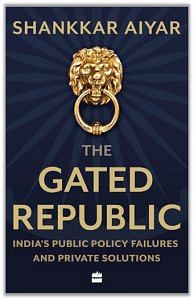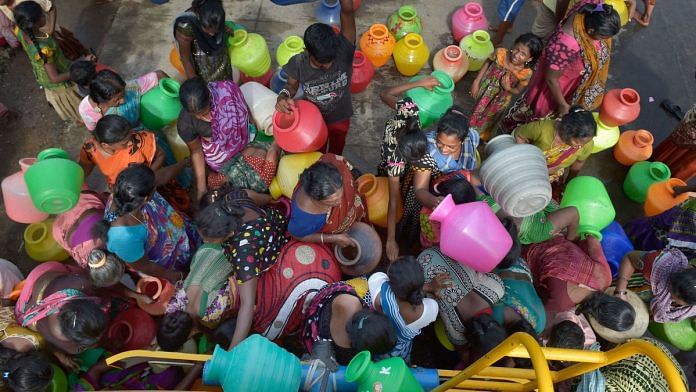Pune, the emergent IT hub in Maharashtra, appears to be dealing with water shortages in a somewhat surreal fashion. The local civic body, the Pune Municipal Corporation (PMC), has virtually offshored its obligation to builders and developers with a kind of undeclared privatization of their water supply department. Builders file ‘water affidavits’ with the PMC while getting building clearances.
In a water affidavit, the builder takes on the onus of ensuring supply of water from the PMC. To bridge the gap between poor supply and demand, the builder enters into deals with tanker-water suppliers, leaving buyers of flats in those buildings high and dry after they have moved in, particularly in Pune’s blazing and increasingly dust-filled summer months, to live with a service poor in both quantity and quality.
Tired of complaining to the PMC, twenty-eight-year-old Balewadi resident Amol Balwadkar, since then a municipal councillor, filed a petition in the Bombay High Court asking for a stay on all new clearances till the PMC fulfilled its primary obligation of ensuring water supply. On 23 June 2017, the bench of Chief Justice Manjula Chellur and Justice Nitin Jamdar ordered a stay on clearances and the issue of occupation certificates in Pune’s Baner and Balewadi areas. On 28 June, the court, in an amendment, directed PMC to file an affidavit through a responsible officer of the municipal corporation on the apartments which have been already occupied, as follows: ‘Firstly, they must say whether the water connections are given and whether those water connections are purposeful and functional.’
Turns out such ‘solutions’ to municipally created problems were not limited to Pune. The Thane Municipal Corporation (TMC) too was clearing building permissions without ensuring supply of water to those buying apartments. Advocate V.P. Patil, like Balwadkar, filed a petition seeking a stay on all new clearances, charging the TMC with denying water to entire societies and colonies, as also supplying less than the stipulated amount when it did allow some water through TMC-controlled pipelines.
Also read: Don’t charge train or bus fare, provide walking migrants food & shelter, SC tells govts
In Mumbai, one of the few Indian cities with a reasonably well-laid grid for water and sewage, the boast of uninterrupted water supply is now a nostalgic memory. The Brihanmumbai Municipal Corporation annually spends over Rs 2,000 crore to distribute water to its residents.
Sitaram Shelar, convener of Pani Haq Samiti, says, ‘Mumbai gets 97 per cent of its water through an elaborate pipe network from as far as 100 km, from the reservoirs of Bhatsa, Tansa and Vaitarna.’ The city’s own rain-fed sources – rivers, lakes, ponds and wells – have either been constructed upon or are dry, choked or polluted.
In a sense, it is already Day Zero in Mumbai, but this is not manifest because nearly 42 per cent of the city’s millions live in slums, as per a 2011 census. While the city corporation supplies 3,800 million litres per day (mld) of purified water, nearly three million citizens are at the mercy of the mafia that collects around Rs 1,500 per 1,000 litres. Kirit Somaiya, a former member of Parliament (MP) from the Bharatiya Janata Party (BJP), estimates that the tankers are making roughly 50,000 trips every year. There is also a parallel shadow economy system where water is procured by the mafia from the corporation on the basis of fudged claims.
Those Indians who live not too far from water bodies and are parched for usable water will vouch that their proximity to rivers or major reservoirs is no guarantee of assured supply. In January 2018, the Gujarat state government announced that it would stop providing water to industries and curtail the release of water to farmlands post March. It told local bodies to look for alternative sources as the water level at the Sardar Sarovar Dam over the Narmada river – the lifeline for 131 urban centres and over 50 per cent of villages – was down to half in January. The scarce reserves were being preserved to provide drinking water during summer.
The spectre of water is scarcity. This is uniquely illustrated in Parasampura, located in Rajasthan’s Ajmer district. Water is padlocked. Residents must padlock water drums and tanks. The village’s panchayat advised them to instal individual locks to prevent water theft and resultant water wars. Water theft here has acquired the same status that cattle theft had in the novels on the wild west in the days of yore. The village gets water once a week.
Apart from preventive measures, citizens have also resorted to precipitative action for water. In Hyderabad, residents hijacked a 5,000 litre water tanker of the Hyderabad Metropolitan Water Supply and Sewerage Board (HMWSSB) that had come to their housing complex. In Navi Mumbai in Maharashtra, residents have complained about tanker operators siphoning from pipelines for sale to housing societies. Aggrieved women in Dhenkanal, Odisha, forced engineers out of the office of the water supply department to check tube wells. In Latur, Maharashtra, authorities had to impose a curfew to prevent water riots. In fact, Section 144 of the Criminal Procedure Code – a ban on the assembly of more than four people – is now part of the legal furnishing used to manage water scarcity in many towns and cities in India.
Also read: India’s urban and rural poor expect different things from their local govts, and why it matters
In May 2018, six villages in Maharashtra, with a population of 30,000, told both political parties, the BJP and Congress, to not bother campaigning in their areas as they were boycotting the by-elections for the Bhandara–Gondia Lok Sabha seat. Why? Because this was the only way left for them to draw the attention of the local and state authorities to the lack of water supply.
In the summer of 2019 actor Leonardo DiCaprio’s social media post brought global attention to how the waterless residents of Chennai had to wait for hours just to get government water- tankers. Outrage resulted in police intervention, IT companies cut operational hours and, in some parts of the city, restaurants started using disposable plates.
The factoids and the locales – from Araria to Agumbe, Bundelkhand to Bengaluru, Champaran to Cherrapunji – reflect the stark reality of a national water crisis thriving at the intersection of circumstance and callousness. It’s almost pitiless, this apathy of India’s contemporary politicians, the slothful administrators and the lack of empathy among elected representatives for the people who vote them into power.
Also read: Why new policies are needed to tackle India’s orphaned wells with no water
It scarcely matters or impacts the business model of the tanker mafia that every few weeks there is an exposé of the nexus between politicians and tanker water suppliers. The tanker mafia, as it is dubbed, rolls on, be it in rural or urban India. A search for ‘tanker- water suppliers in India’ on the internet delivers over 4.6 million results in nano-seconds. Directories and e-commerce sites even offer specialized listings of tanker-water suppliers for Maharashtra or for specific locations across sixty towns next to each other. A search for ‘RO water tankers’ (water filtered with reverse osmosis process) throws up 26 lakh results – options range from stainless steel tank carriers to jars of water. There are specialists who cater to conferences, marriages, funerals and public events.
The question is often asked: ‘If there is no water, where are these water suppliers getting so much of it from?’ The second question, often asked, answers the first: ‘Why is no one doing anything about these tanker lobbies and water mafia?’ Then, its own answer, invariably with a sigh and what has become that typical Indian resigned shake of the head: ‘These politicians.’
The very convenient Indian matrix which divorces authority from accountability has allowed politicians and babudom to escape blame. The over-extraction of groundwater has resulted in the fall of water tables to such depths that groundwater is now being mined. The failure of politicians – intentionally and inadvertently – to institute and execute policy in favour of the public has led to private profit turning groundwater into a mining industry.
***
And so Indians are desperately seceding, as soon as their income allows, from dependence on government for the most basic of services – water, health, education, security, power – and are investing in the pay-and-plug economy.
 This excerpt from The Gated Republic: India’s Public Policy Failures and Private Solutions has been published with permission from HarperCollins India.
This excerpt from The Gated Republic: India’s Public Policy Failures and Private Solutions has been published with permission from HarperCollins India.




I think the argument of controlling population is a bygone. This should have been done during the 80’s. Now the TFR is already 2.24 which will soon become 2.1 (replacement rate). What we need to do ASAP is to invest in basics like water, sanitation, power, housing, health, edu, hard infra in almost every sector. But hey, we can dole out a loan waiver and win the election. As long as we keep making costly and shoddy agricultural policy to placate the farmer’s vote bank (and continue to keep them poor) and keep using more than half the budget just for salaries and pension to useless bloated govt machinery (most of which can be replaced by a software), we wont have the money to do anything remarkable.
“Sapne dekh par sach hone ki maang na lagao”.
As long as Indians procreate like rabbits they can only blame themselves. Stop making babies and spare them of the hell that is India.